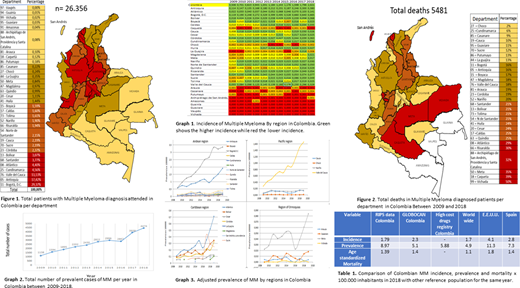Background
Multiple myeloma (MM) is a heterogeneous and incurable disease that evolves from asymptomatic premalignant conditions. The worldwide incidence, prevalence and mortality are well known thanks to data reported by the International Agency for Research on Cancer (IARC) and by the GLOBOCAN World Cancer Observatory. The data provided by Colombia to these reports comes from the population cancer registries corresponding to 5 cities whose most up-to-date data are from 2018. National data can also be found in the base of the high-cost account. Although it is true that there are excellent sources of information, it is believed that there is a significant underreporting of the prevalence of the disease, which makes it necessary to optimize the information to achieve the establishment of programs oriented to work on better control of this type of hematological cancer. The study MiMENTe (Mieloma Múltiple Epidemiología Nacional y territorial) is a collaborative effort to know the reality of the disease in terms of incidence, prevalence and mortality in Colombia as a first step to control the disease even in the premalignant stages for the future wanting to position itself as a model for the control of MM in developing countries.
Methods
MiMENTE (Mieloma Múltiple, Epidemiología Nacional y territorial) is a multiphase study that is going through its first stage through a cross-sectional study in Colombia. The total population diagnosed with Multiple Myeloma (ICD Code 10 C900) during the 2008-2018 period was included in the RIPS Individual Service Delivery Registry in Colombia and a comparison was made with the available data from GLOBOCAN (Global Cancer Observatory) and High Cost Account. Records that had an unidentified diagnosis were excluded.
For this phase, a comparison is made of the data from the registries of the three entities described, three measures of frequency are established: Incidence, prevalence and mortality, standardizing the latter by means of a direct method, making the Colombian population comparable with large countries such as the United States. and Spain cataloged as centers of reference in the management and diagnosis of Multiple Myeloma. Variables such as ethnicity, age, place of origin, health regime, place of death will be studied in the future in later phases of the study.
Results
Between 2009 and 2018 (10 years), 26,356 MM diagnoses were found throughout the national territory of Colombia. The departments where the most attention to patients with this diagnosis was presented were Cundinamarca, Valle del Cauca, Antioquia, Santander, Bolívar and Atlántico Figure 1.
The standardized incidence rate for Colombia in 2018 was 1.79 x 100,000 inhabitants, being higher in the Andean region as shown in the heat map. Graph 1. The total number of prevalent cases per year varied from 1138 cases in 2009 to 4474 cases in 2018 being for this year the adjusted prevalence of 8.97 x 100,000 inhabitants / year Graph 2. When the prevalence is analyzed by regions it is higher in the Andean region Graph 3.
During this entire period of time, 5481 deaths were found, being 20.80%. The highest mortality occurred in the departments of Vichada, Meta, Caquetá, Risaralda, Atlántico and the island of San Andrés. Figure 2. The age-standardized mortality rate for Colombia is 1,39x100,000 inhabitants (Adjusted with the population of the United States).
The most up-to-date data from IARC and GLOBOCAN are those corresponding to the year 2018. A comparison was made of our data with those reported in this last registry for Colombia in addition to the high-cost account. Comparative data were developed with the population of the United States, standardizing this population and it was also compared with the data reported for Spain. The prevalence of the disease is higher in Colombia than reported by GLOBOCAN, IARC and High cost drug account Table 1.
Conclusion
This is the first report of the MiMENTe study that shows the incidence, prevalence and mortality of patients with 10-year-old multiple myeloma in Colombia. The prevalence of the disease is higher than that reported by international registries. The regions with the highest incidence were those belonging to the andean region. The highest prevalence was confirmed in Bogotá and Antioquia and the highest mortality was observed in the Orinoco region.
Idrobo:Takeda: Honoraria, Speakers Bureau; Janssen: Honoraria, Speakers Bureau; Tecnofarma: Honoraria, Speakers Bureau; Amgen: Honoraria, Speakers Bureau; Abbvie: Honoraria, Speakers Bureau.
Author notes
Asterisk with author names denotes non-ASH members.


